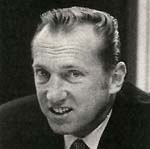Do We Need an Anti-Siphoning Act in the United States?
 The remarkable Milwaukee Brewers have now reached the second round of the Major League Baseball play-offs, but many Brewers fans have yet to have the opportunity to stay at home and watch the team play post-season games on television. The reason, of course, is that this year all first round play-off games as well as the second round of National League play-offs are shown only on cable television. Those who don’t subscribe to cable are shut out of watching the Brewers on television, unless they can make their way to Long Wong’s Sports Bar on Blue Mound Avenue, or some other similar establishment.
The remarkable Milwaukee Brewers have now reached the second round of the Major League Baseball play-offs, but many Brewers fans have yet to have the opportunity to stay at home and watch the team play post-season games on television. The reason, of course, is that this year all first round play-off games as well as the second round of National League play-offs are shown only on cable television. Those who don’t subscribe to cable are shut out of watching the Brewers on television, unless they can make their way to Long Wong’s Sports Bar on Blue Mound Avenue, or some other similar establishment.
This was, of course, not always the case. Until 1996, all Major League Baseball post-season play-off games were on free television. That year, ESPN won the right to broadcast any first round play-off games not aired by NBC or FOX, then Major League Baseball’s primary broadcast partners. Since that time, the number of play-off games on pay television has been steadily creeping upward.
In Australia and in many European countries, the local equivalent of Major League Baseball’s playoff games would be required by law to be broadcast on free television. Called anti-siphoning statutes, these laws dictate that certain sporting events must be made available for broadcast on free, open-air stations, if they are broadcast at all.
In Australia, for example, every regular season and play-off match played in both the Australian Football League Premiership (Australian Rules Football) and the National Rugby League—the country’s two most popular sports leagues—are on the anti-siphoning list. On the list as well are a host of other sporting events, many of which take place outside of Australia, ranging from the FIFA World Cup to the U.S. Masters Golf Tournament to all test matches played by Australia’s senior representative cricket team.
In the European Union, the 2007 Audiovisual Media Services Directive encourages individual members to adopt similar protected lists, and guarantees legal immunity from any other EU rule or regulation that might arguably apply. Such guarantees exist in a variety of European countries, including Austria, Belgium, Denmark, Finland, France, Germany, Ireland, Italy, and the United Kingdom.
The failure of Arab countries to adopt such statutes meant that the vast majority of Arab citizens were not able to watch, at least legally, the 2006 World Cup, because the exclusive broadcast rights were sold to a single satellite broadcaster that charged exorbitant rates for its signal. (I have written about this issue in some detail in an article entitled “The Over-Protection of Intellectual Property Rights in Sport in the United States and Elsewhere” that appeared in the Winter 2011 issue of the Journal of the Legal Aspects of Sport.)
Almost twenty years ago the United States Congress expressed concern about the migration of high profile sporting events to pay television when it adopted the Cable Television Consumer Protection and Competition Act of 1992, which authorized the FCC to study the issue. To date, most of the major sporting events in the United States—the World Series, the NCAA Final Four, the NBA Finals, and the Super Bowl—remain on free television, but that may soon change.
In recent years, a variety of popular sporting events have been shifted to pay television, including most of the races constituting NASCAR’s Chase series, early round play-off games in the NBA and NHL, as well as Major League Baseball, two of the four tennis majors, and one of golf’s four majors. Moreover, last year the BCS championship game was, for the first time, broadcast exclusively on cable television (ESPN), and will be for the foreseeable future.
That there has not been more uproar over the recent shifts may reflect that fact that an estimated 75% of the United States population now has access to basic cable or satellite television, placing those of us who do not in a distinctively minority position.
Furthermore, whether an American anti-siphoning law could withstand First Amendment scrutiny is an interesting question. Early on in the history of cable television in the United States, the FCC issued a draconian guideline that essentially prohibited cable television broadcasters from airing any live sporting events at all (as well as prohibiting original programming not first shown on free television). This rule was struck down by the D.C. Circuit Court of Appeals in Home Box Office v. FCC, 567 F.2d 9 (D.C. Cir. 1977), but that directive was far more restrictive than any modern anti-siphoning statute, all of which permit the simultaneous broadcasting of events on free and pay television. However, given the solicitude shown for commercial speech by the current United States Supreme Court, the fate of such legislation is hard to predict.
As a baseball fan, I feel aggrieved by not being able to watch the Brewers games on free television. However, so far I do not feel aggrieved enough to subscribe to cable television or, for that matter, to complain to my Congressman. For the time being, I will just have to root for the Brewers to make it to the World Series, which, thankfully, is still on regular television.

